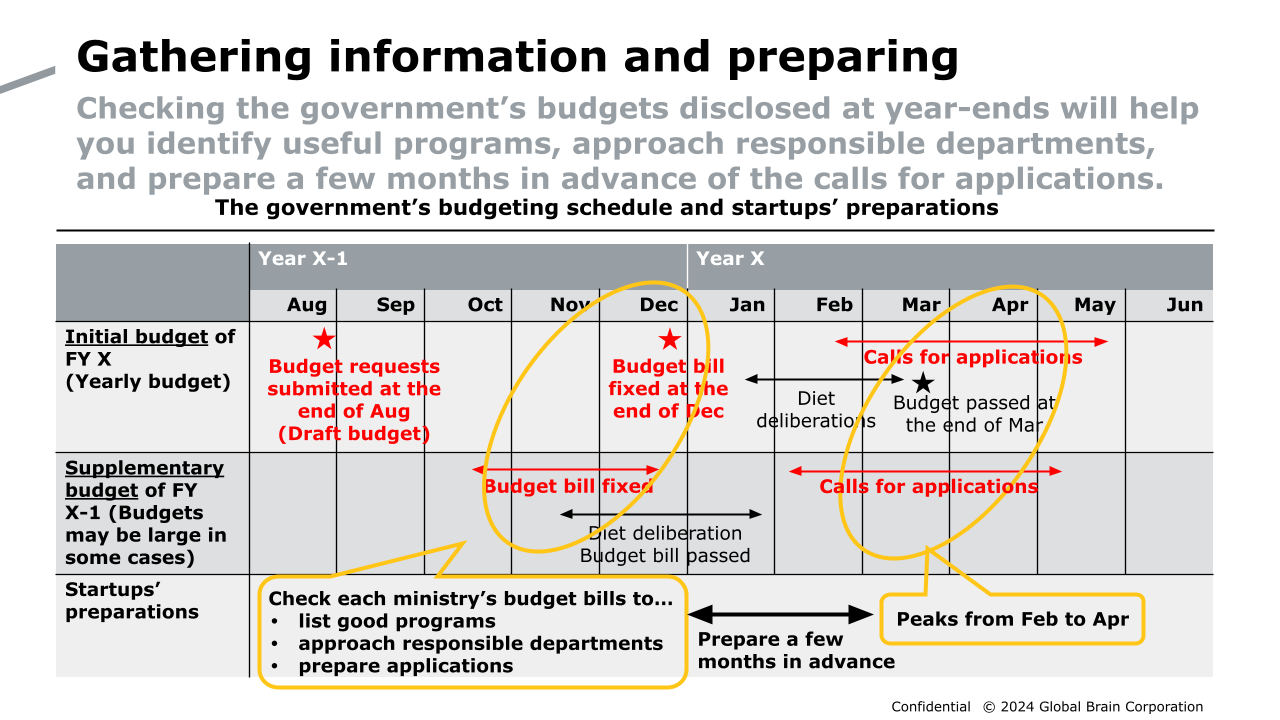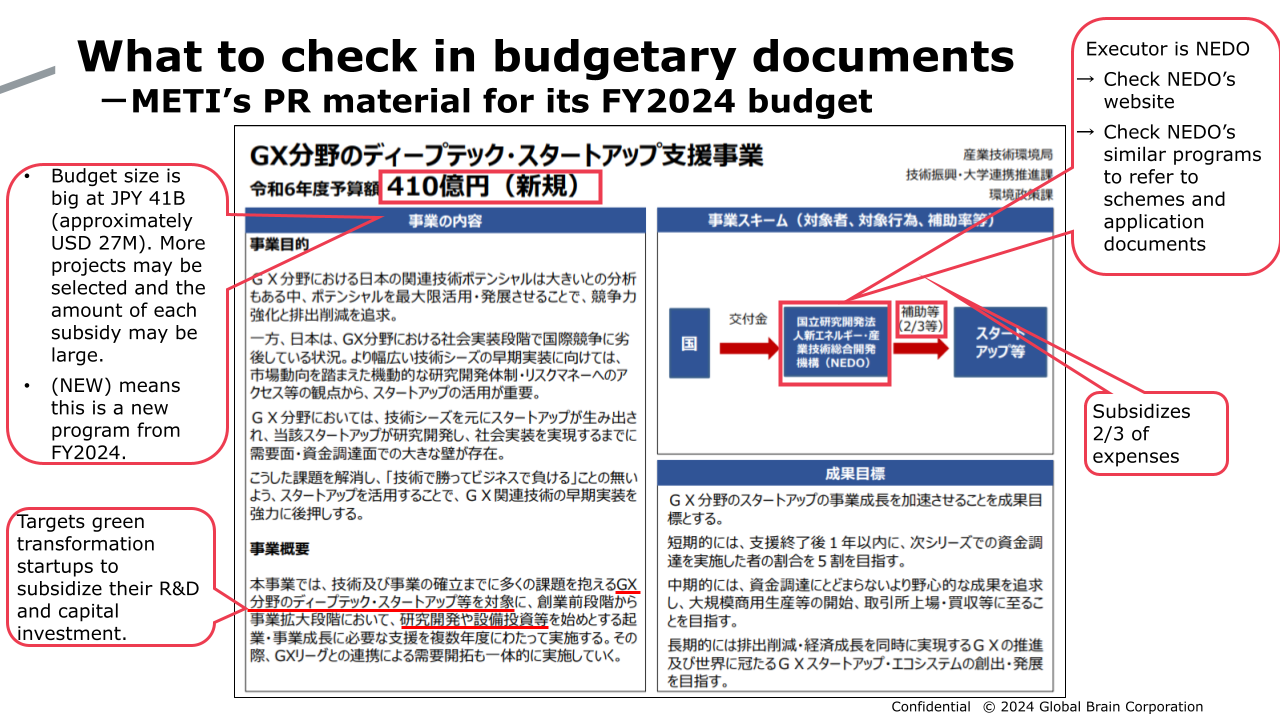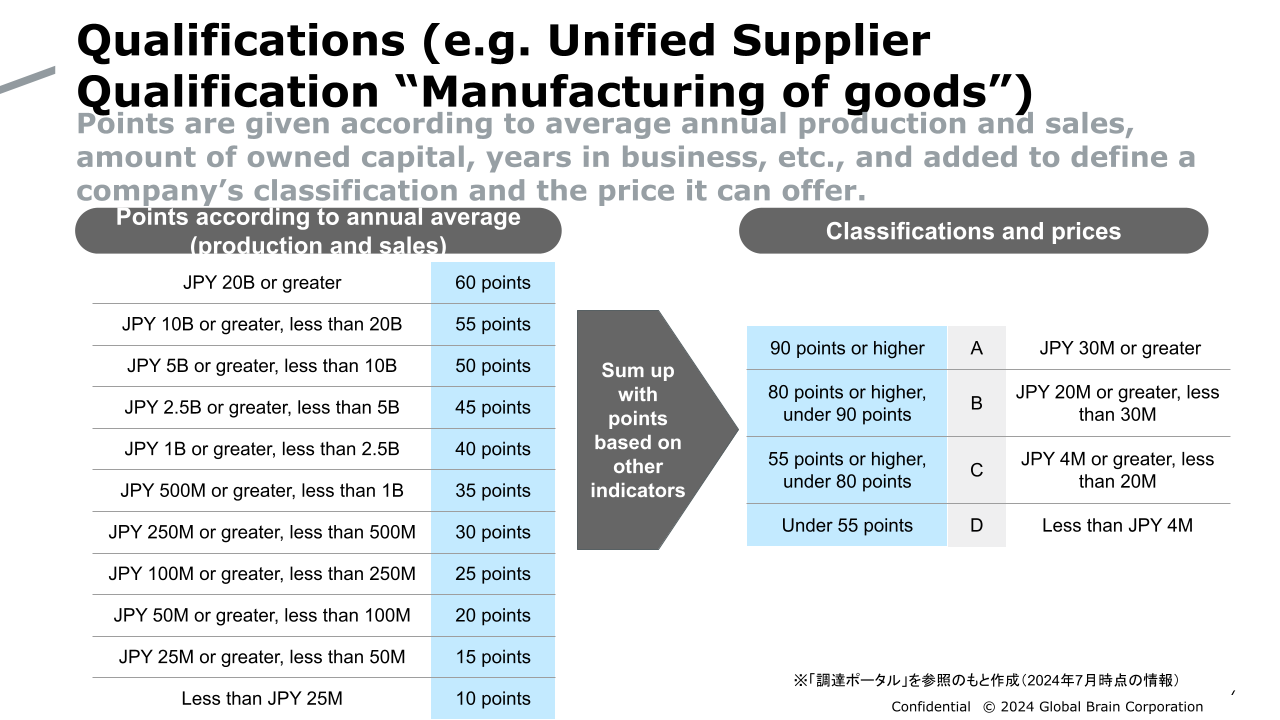The Basic Steps of Startup GR
This article covers the key points of Government Relations (GR) activities and how to engage the Japanese government and local municipalities.

Written by Ko Kawaragi, edited by the Universe Editorial Team
My name is Ko Kawaragi, responsible for GR for our portfolio startups at Global Brain (GB). I compile information on government support programs looking at each program’s objectives and scopes, share the information with our portfolio startups to help them stay updated, and develop strategies to address laws and regulations.
As I explained in my previous article, GR for startups is about engaging the government and municipalities to achieve business growth. Positive outcomes include acceleration in research and development, reduction in implementation costs for customers, legal and regulatory compliance and reforms, and acquisition of public sector customers.
In this article, I would like to go over the basic steps for a startup to commence their GR activities.
There is no one-fits-all theory for GR activities, but it helps to break down the process into three steps.
- Clarify your objectives
- Identify actions for each objective
- Establish a structure to take action
From here, let’s look at each step in depth.
1. Clarify your objectives
You first need to clarify what you intend to achieve through GR activities. To give you some examples,
- Use government programs to accelerate research and development
- Use government programs to reduce your customers’ implementation costs
- Address and reform laws and regulations to create a better business environment
- Make the public sector your customer and achieve business growth
You might feel it is obvious that “clarifying your objectives” should be the starting point. But surprisingly enough, we often come across initiatives with inconsistent objectives and actions that journey off in the wrong direction all because they kicked off without a clear-set goal.
Launching a GR initiative with the motivation to “be accredited and adopted by the government in order to increase brand awareness” might be one example. Although it does depend on the business model of a company, GR is not always the best answer to boost brand recognition. In order to have consumers recognize your business, it could be more effective to adopt a PR strategy such as working with the media. If you do not have a full grasp of what exactly is needed to achieve your objective of “increasing brand awareness,” you might end up clinging to GR activities instead of pivoting to PR activities–your measure becomes a target and it ceases to be a good measure.
It is absolutely crucial to start brainstorming measures after you have a clear objective set out, asking yourself whether GR is truly the thing you need.
2. Identify actions for each objective
When your company’s objectives are set and you are confident GR is needed, the next step to take is to set actions. Let’s look at what the possible actions are based on the examples of objectives I shared above.
Case 1. Use government programs to accelerate research and development / Use government programs to reduce your customers’ implementation costs
These two both include using government programs and therefore will basically follow the same steps.
Here, gathering information as early as possible on the government programs that your company and your customers can benefit from is important. I wrote “as early as possible” because the application deadlines for most subsidies are only about one month after the programs are announced and because of this short timeframe many who start preparing after the calls for applications are made cannot meet the deadline.
Applying for a government program takes up a hefty amount of time. You need to check whether your company satisfies the objectives and requirements, fix the concept of your project, shake hands with internal and external stakeholders, calculate expenses, and compile application documents. One month is too short for a startup with limited resources to prepare a neatly organized and professional application document.
The government carries out its budgeting process each fiscal year, which is why February to April is the peak season for calls for applications. Prior to this, at the end of December every year, each ministry will upload their following fiscal year’s budgets on their websites which I highly recommend you to check as soon as they come up. Getting a rough grasp of the programs such as “the objectives, scopes, and budgets” a few months before the grant calls will help you to identify programs that may be of use for your company, reach out to the responsible department, and take action to raise the odds of your applications being approved.
Also, the government often secures large supplementary budgets in addition to the fiscal budgets (called the initial budgets). You can check the approximate budget sizes on each ministry’s websites from around October to December.

For example, the Ministry of Economy, Trade and Industry’s FY2024 budget proposal document (available in Japanese only) disclosed in December 2023 tells “who” and “what initiative” each budget is secured for. Referring to it can help you see whether your company is in scope. Also, by knowing which institution (NEDO in the example below) is responsible for executing the budget, you will be able to check the institution’s website and stay on top of grant call updates.

Although recent years saw a significant expansion in support programs for startups, heightened interest from the startups are intensifying competition over subsidies every year.
For example, NEDO’s recent Deep-Tech Startups Support Program only adopted 15 companies out of the 69 applications that were submitted (available in Japanese only). The competitive ratio was 4x to 5x, not easy to pass. To submit a thorough and well-prepared proposal, it is probably certainly effective to check the program details and requirements as soon as possible and have your plans laid out.
Case 2. Address and reform laws and regulations to create a better business environment
The next set of steps I would like to share is what you need for lobbying activities.
Here, the first step is to consider in what kind of environment you will be able to accelerate your company’s growth, and start from there to identify which rule you need to change and how. Depending on whether the rule you must change is a law; a Cabinet Order, Ministerial Order, or guideline that comes under laws; or an industry self regulation, stakeholders and timings differ.
Once you have identified which rule you need to address or change, the next step is to start gathering information on who the stakeholders are and what their positions are. Various stakeholders impact the rules of a country: politicians, ministries and agencies, local municipalities, industry groups, consumer organizations, and academic experts.
Looking at this list, you need to think about who will and for what reason they will either endorse or oppose you to change the rules by checking each stakeholder’s websites and social media accounts, government council minutes, interviews to relevant people, and other sources.

The most important step here is to build stories and logic to motivate each stakeholder to take action. If you insist on changing the rules “just for the sake of your own company’s growth,” that might be a difficult task to achieve. To talk with politicians and government ministries, you need a logic that explains how changing the rule could solve social issues. For stakeholders who are likely to oppose, you need to think about how to alleviate or eliminate their concerns.
One effective way might be to form an industry group with other companies that share the same awareness of the problems, so that you can lobby the stakeholders as one whole industry and make your voices heard instead of doing this as one single company.
Case 3. Make the public sector your customer and achieve business growth
The public sector includes various players including ministries and agencies, incorporated administrative agencies, universities, prefectures, and municipalities. And they can be customers for a wide range of things from public works to product purchases, and service contracts such as SaaS. Therefore, you need to gather and compile information with the aim of building a hypothesis on “what deal you want to close with which public institution”.
Generally, in public procurement projects (where a public institution purchases a private company’s offering), a public institution makes an open call for applications to multiple service providers. Ministerial projects that are currently open for applications are disclosed on the Procurement Portal (available in Japanese only) and the projects of local municipalities are disclosed on their respective official websites. You can also find some information on past procurement contracts including project titles, company names, and deal sizes on each public institution’s website. Many companies use databases like NJSS (available in Japanese only), which provides information on currently open and already closed projects of local municipalities.
Gathering and analyzing this kind of information will help you develop a hypothesis for your business like this: “Looking at sectors similar to our business, there are prefectures and ordinance-designated cities that have procurement projects of approximately JPY XX million per deal and they have contracted with startups in the past. It might be good to prepare for the tender that will take place every year in around the month of XX.”
Another thing you want to consider when taking part in a public tender is to become a “qualified supplier”. In government tenders, companies are ranked based on their business sizes and years in business and their ranks determine the size of the deals they can place bids for. Municipalities have their own separate qualifications. Depending on who the project is for and what the size is, you are required to obtain different qualifications.

To add to that, as I shared in my previous article, the government has been embarking on initiatives to allow for greater participation (available in Japanese only) of startups in large deals regardless of their qualified supplier rank as part of their support to startups*. It would be effective for startups that feel the bar is too high to become a qualified supplier to make full use of such initiatives.
- This is for startups that have been adopted for specific grants or have been accredited, funded, awarded, etc. by the government.
3. Establish a structure to take action
Step #2 is resource-consuming enough by itself and you need even more preparation to execute your plans.
However, it would be wrong to say that all startups should form their own GR teams from the very beginning of their businesses. The more realistic approach would be to take a step-by-step approach and form a structure based on a startup’s business model and its priorities, starting by considering whether it is preferable to have a CxO wear two hats and take care of GR or to have a dedicated team.
For example, startups in sectors like finance, medicine, mobility, and communication that have no choice but to address laws and regulations, and startups in defense, space, or deep tech that aim to acquire government grants for research and development or close large procurement projects, will likely need a GR person from an early stage in their businesses. Other startups would want to first identify their objectives and actions by taking steps #1 and #2 before they start considering whether they need to allocate dedicated resources for a GR function.
If you do not feel the need to secure your own resources but still want to regularly gather information on government policies and apply for grants, working with VCs like us or other third parties is another option on the table.
Wrap-up
I have now reached the end of my article. To startups who are interested in GR but not sure where to start, I hope you find the basic steps I covered in this article useful when planning your actions.
However, I imagine many of you may feel worried that the bar is too high or you are not aware of the rules you need to know when approaching bureaucrats and assembly members–which is why my next article will be about What Politicians and Bureaucrats “Actually Feel” about Startups.
(Follow Global Brain’s official X account to get updates on GB Universe articles.)

Ko Kawaragi
Global Brain
Corporate Management Group
Director, Researcher
Joined GB in 2023. Responsible for Government Relations for startups and researching global investment trends.